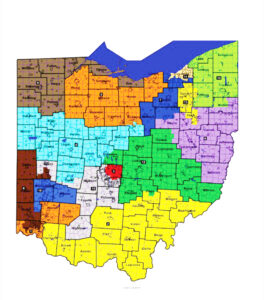City pledges to reduce emissions 30 percent by 2030
Warren becomes 12th community to join clean-energy organization
WARREN — Working to reduce Warren’s carbon emissions 30 percent by 2030 while simultaneously adding new jobs is a goal Mayor Doug Franklin made when Warren became the 12th community to join Power A Clean Future Ohio.
“Thirty percent may be an ambitious goal, but we know the new wave of jobs will be driven by clean energy,” Franklin said. “By joining this organization, we will be on the forefront of job creation and finding equitable solutions.”
The 30 percent reduction is based on 2010 emission levels.
Power A Clean Future Ohio is a nonpartisan coalition and campaign that is dedicated to working with local communities to develop equitable clean energy solutions to benefit the well-being of residents, the environment and the economy. The coalition was launched in February 2020.
It is working to try to get Ohio cities “to reduce emissions and develop local clean energy polices,” Joe Flarida, executive director of the coalition, said. It can provide technical advice and research for communities in reducing their energy emissions.
Other cities in the coalition are Lorain, Lakewood, Euclid, Lima, Dayton, Cincinnati, Silverton, Bexley, Reynoldsburg, Lancaster and Athens.
Representatives of Power A Clean Future Ohio approached the city about joining because of the work city leaders have been doing with Nature’s Conservancy in cleaning up the Mahoning River.
Using the new connections being made through this coalition, Franklin is hopeful the city will be able to reduce its carbon emissions significantly.
“We will be doing best practices to reduce emissions, including eventually changing our vehicle fleet from gas-powered to electric,” Franklin said. “We may not finish during my administration, but we will lay the ground work.”
Franklin said the city is willing to look at a variety of ways of helping companies reduce their carbon emissions, including exploring energy credit buy backs.
While recognizing the city’s manufacturing past and ties to traditional fossil fuels, Franklin noted companies such as WCI Steel, Delphi Packard Electric, General Motors automaking and General Electric lamp plants no longer are in the area.
“We can’t live in the past,” he said.
Franklin did not outline specific ways the city will achieve carbon emission reductions but is open to exploring suggestions.
The two new natural gas-powered electric power plants, Lordstown Motors Corp. and other companies now growing in the Valley give Franklin optimism toward a low-emission future.
Mike Chadsey, spokesperson for the Ohio Oil and Gas Association, said the discussion should be about providing energy choices to residential and commercial customers based on price, availability and reliability of services.
“Ohio already is leading the way in carbon-generation reduction,” Chadsey said. “In the last several years, We’ve seen several coal-fired power plants go offline. We’ve also seen several gas power plants come online.
“Consumers should have choices in the types of energy they want to consume,” Chadsey said. “We want to make sure you have reliable sources of energy based on availability and price.”
Chadsey called Ohio an energy-diverse state, which has companies producing energy from nuclear power plants, as well as from coal, natural gas, gasoline, geothermal and others.
“Diversity is a good thing,” he said. “Having a diverse energy grid drives down prices due to competition.”
Chadsey also said Ohio’s manufacturing facilities need base load power. “Part of a base load energy source is natural gas,” he said. “You can have a strong economy while reducing a city’s carbon emissions. These are not mutually exclusive.
“The obvious example is Lordstown where you have two natural gas-burning electric plants,” he said. “You also have one of the state’s first electric truck manufacturing facilities.”
Chadsey said Ohio has 200,000 residents working in the natural gas industry, so making sure these Ohioans can continue to work and thrive is important to the growth of the state.
BRITE Energy Innovators, which has had offices in Warren since 2015, joined Power A Clean Future Ohio about a month ago, according to Sara Daugherty, director of partnership.
“We joined to help our clients, energy-tech startups, make contact with cities across the state that are looking for better ways to have clean, reliable power,” she said. “We’ve able to connect two of our customers to new clients trough Power Clean Power Future Ohio.”
Greg Lawson, a research fellow with the Buckeye Institute, said communities voluntarily taking actions to reduce their greenhouse effect is something the institute can support.
“However, communities have to be careful how they do it, so it does not lead to high energy costs,” Lawson said. “People should know if companies are paying some sort of offset energy credits, instead of actually obtaining their energy from solar panel or wind-energy farms.”
Lawson acknowledged some transition is taking place, where people and businesses are moving away from traditional coal-fired and oil-burning plants to provide them with energy.
“Communities have to be smart in making their choices,” Lawson said. “Ohio has a lot of natural gas sources, and they worked in making the transition.”
More than 50 businesses and organizations support Power A Clean Future Ohio’s goals, including BRITE, Chambers for Innovation and Clean Energy, Gray Consulting Group, Johnson Controls, Mayor’s Partnership For Progress, Ohio Citizen Action, Ohio Hospital Association, Ohio Land Bank, Ohio Mayors Alliance, Sierra Club and the Toledo Regional Chamber, among others.

